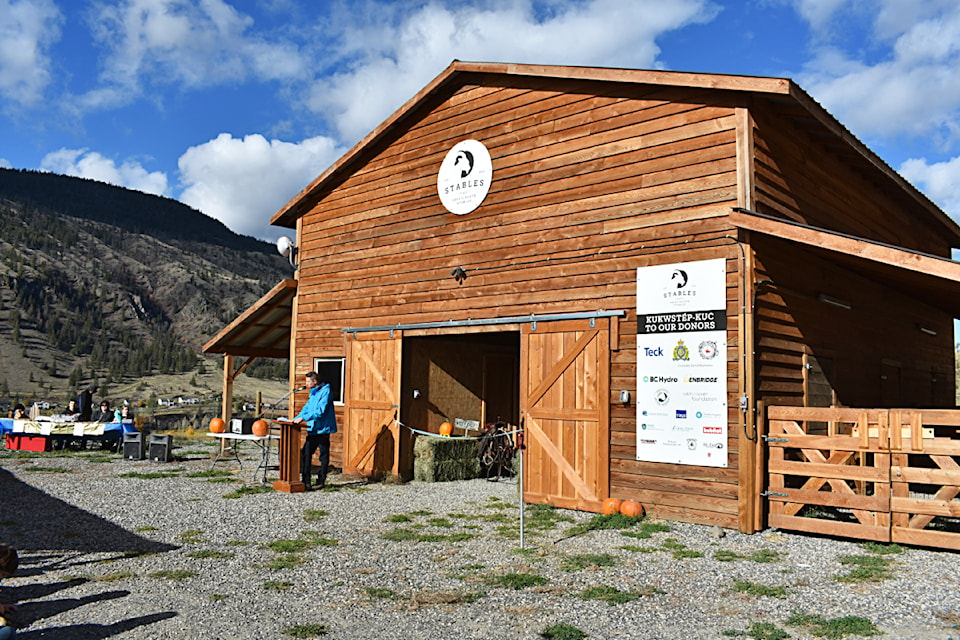The “On the Land” learning facility at Skeetchestn Community School west of Kamloops saw the grand opening of the Skeetchestn Stables on Oct. 17, a major addition to the school which will provide students with an immersive and "hands on" learning environment where it's OK to get dirty.
The Skeetchestn Stables is part of a program which connects youth to the land, and fosters in them an appreciation for agriculture, animal husbandry, and sustainability. By getting their hands dirty, students cultivate more than just the land: they cultivate knowledge, responsibility and respect for the environment.
The latest addition to the On the Land facility is more than just stables, but Bryce Ross — principal of Skeetchestn Community School — says he couldn’t resist the alliteration.
“We also showcased the new pit-house, smokehouse and tanning shack, as well as the school barn, which has animals like chickens, goats and pigs,” he explains.
“It’s all part of a push for food sovereignty that’s been going on for about six years. There’s been money and effort put forth for raised garden beds and a food forest near the school, and the Skeetchestn Stables has been in the works for the last two-and-a-half years. It’s the next layer to food sovereignty, teaching students about the symbiotic relationship between gardening and farming.”
Ross says the facility is an attempt to regain the connection people have lost with their food. “Nobody goes to the grocery store and picks up a bell pepper and thinks how much work went into this; they just toss it in the cart.”
Students have been planting and harvesting potatoes, carrots, tomatoes, herbs and other items that are used in the school kitchen, and there is a community garden as well that the school is promoting. Students have also prepared baskets of food and delivered them to Elders, a tradition that Ross wants to keep up.
“The food forest is based on the swale system up the side of a hill, with many different fruit trees. The system makes sure each tier uses water efficiently, and the water cycles through and down from the top. It was planted about six years ago and is quite well-established.”
Ross says that the animals won’t be butchered. “We’re teaching empathy, and how to raise them properly and look after them.” He adds that the surplus from what the students grow will benefit the animals, while what they can get from the livestock will benefit the garden and food forest.
“We’ll get manure from the barn, and can use it in the garden after it sits long enough. We can use bunny manure right away, but how long does chicken manure have to sit before we can use it? Students are learning that aspect, and about feeding and watering the animals. They’re also lifting hay bales and doing heavy work, and the animals will be a therapeutic addition to school work. It’s multi-faceted.”
Skeetchestn Community School is a K–12 facility, and Ross says students' experiences will vary depending on their age.
“The kids in Kindergarten through Grade 5 love the fact that they get out with the animals, so it’s more therapeutic, social, emotional. Kids in Grades 6 through 12 are more interested in helping, and getting their hands dirty.”
The pit-house, smokehouse and tanning shack are also a part of language and culture learning.
“Our pit-house is a modern take on a traditional one, and we envision having 80 per cent of our language and culture classes occurring there, as part of an ongoing story of getting kids outside in an authentic manner. Everyone talks about ‘on the land’ learning, but what does that look like? We’re trying to do it in an authentic manner.
“The smokehouse is intended to smoke meat or fish from hunters who donate to the school, or from the community during fishing season, and we’re teaching students to brine fish. The tanning shack is for when someone donates a hide, where students can learn to clean and stretch and prepare it.”
Ross adds they also have a root cellar for storage, and a food processing hub (“Essentially an outside kitchen with a cover”) where they hold events teaching people how to do pickling and canning.
“And it’s always ‘what’s next’? It would be really neat to get some bees, to expand and grow in that way and continue to grow community interest. We picture this as a living document where we can add to it.”
Ross says he hopes more school districts, and the provincial and federal governments, fund more initiatives like what Skeetchestn is doing.
“We need funding for these projects to come to fruition, and people need to lobby for this. We need to employ people like agricultural coordinators, because teachers and principals can’t do this off the side of our desk. And we need to act fast and teach kids to look after themselves, because the next 25 years aren’t looking so good.”
He adds it’s great to see kids forming an authentic engagement with the land.
“Kids are really excited to get into the barn and work with animals and get their hands dirty. A bunch of kids raise their hand when I say I need someone to help muck out a stall. As educators we’re competing with technology, and we need to be more entertaining than that screen a lot of students are in front of for long portions of the day.”



